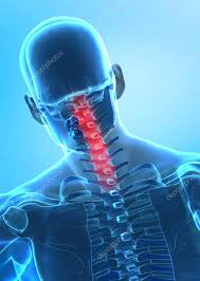Here’s a Great Recipe to Warm Us All Up!
[amd-zlrecipe-recipe:3]
Today’s Rice Pudding Recipe was shared from the following website: https://sweetleaf.com/stevia-recipes/sugar-free-cinnamon-vanilla-rice-pudding/
[amd-zlrecipe-recipe:3]
Today’s Rice Pudding Recipe was shared from the following website: https://sweetleaf.com/stevia-recipes/sugar-free-cinnamon-vanilla-rice-pudding/

A healthy spine is an often overlooked and essential part of a healthy lifestyle. People who suffer from back pain, particularly if it is long-term, are generally less healthy than those who do not. In fact, back pain costs are staggering not only financially, but also in terms of lost time from work and because of psychosocial problems that arise during the healing process associated with long-term back pain.
Unfortunately, approximately 80-90% of the population suffers from spinal pain at some point. People who are overweight or obese, and who smoke, lift heavy objects, or had a previous episode of back pain, are more likely to experience back pain.
Because so many people suffer from spine pain, it’s important for you to try to keep your spine as healthy as possible. Following simple posture, lifting, and healthy lifestyle guidelines can help you keep your back in good shape. One of the best things you can do for your spine is to get regularly adjusted. If you are in need of an adjustment, be sure to call our office at 406-652-3553 and schedule an appointment with Dr. Oblander. In the meantime, here are some good ways to take care of your spine:
The American Chiropractic Association recommends the following spinal health tips:
Standing
• When standing, keep one foot slightly in front of the other, with your knees slightly bent. This position helps to take the pressure off your low back.
• Do not stand bent forward at the waist for prolonged periods of time. The muscles in your low back become deconditioned in this position, which may lead to pain.
Lifting
• At all times, avoid twisting while lifting. Twisting is one of the most dangerous movements for your —spine, especially while lifting.
• If the item is too heavy to lift, pushing it is easier on your back than pulling it. Whenever possible, use your legs, not your back or upper body, to push the item.
• If you must lift a heavy item, get someone to help you.
Sitting
• Keep your knees slightly higher than your hips, with your head up and back straight.
• Avoid rolling your shoulders forward (slouching).
• Try to maintain the natural curve in your low back.
Reaching and Bending
• When reaching for something above shoulder level, stand on a stool. Straining to reach such objects may
not only hurt your mid-back and neck, but it can also bring on shoulder problems.
• Do NOT bend over at the waist to pick up items from the floor or a table.
• Instead, kneel down on one knee, as close as possible to the item you are lifting, with the other foot flat on the floor and pick the item up.
• Or bend at the knees, keep the item close to your body, and lift with your legs, not your back.
Carrying
• When carrying objects, particularly if they are heavy, keep them as close to your body as possible.
• Carrying two small objects—one in each hand—is often easier to handle than one large one.
Healthy Diet and Exercise
• While the proverbial jury is still out, we suspect that extra weight puts undue strain on your spine. Keep within 10 lbs. of your ideal weight for a healthier back.
• “Beer belly” is likely the worst culprit, as it puts unwanted pressure on the muscles, ligaments and ten- dons in your low back.
• The most efficient and effective way to reduce weight is by eating a sensible diet and exercising regularly.
• Consult with your doctor before beginning any exercise program, particularly if you have a health condition.
Sleeping
• Sleeping on your back puts approximately 50 pounds of pressure on your spine. Other positions may be better
.
• Placing a pillow under your knees while lying on your
back cuts the pressure on your spine roughly in half.
• Lying on your side with a pillow between your ——– knees may also reduce the pressure on your back.
• Never sleep in a position that causes a portion of —- your spine to hurt. Most often, your body will tell you what position is best.
Quit Smoking
Smokers have more spine pain than nonsmokers, and they also heal more slowly when they have an episode of back pain because the chemicals in tobacco smoke restrict the flow of blood to the tissues in and around your spine.
While following these instructions is no guarantee that you’ll be free from back pain for your entire life, it can certainly reduce your risk of developing it. These simple steps will help you keep your spine in good shape, making you a healthier, happier person.
Lawrence H. Wyatt, DC, DACBR, FICC, Professor, Division Of Clinical Sciences, Texas Chiropractic College, Writer
Nataliya Schetchikova, PHD, Editor
This health article was shared from the following website: http://www.chiroworkscarecenter.com/documents/Articles/ACA_healthy_spine.pdf
[amd-zlrecipe-recipe:2]
[amd-zlrecipe-recipe:1]
Here is a healthy, low-sugar and no refined sugar recipe! You might think about making a batch for Sunday brunch this weekend!

Today we are sharing an article from Forbes magazine on how losing weight can save you money. Just ask our doc – Dr. Greg Oblander, losing weight saves you more than just money. Think that you are doomed to all of the health woes and diseases that have plagued your parents and grandparents? Would it surprise you to know that genetics only affect about 5% of health issues? Yup, it’s true. Our health is mainly determined by our health and lifestyle choices. Love that Big Mac? Well…it doesn’t love you! Today’s article cites a report that estimates that losing weight will save the average person at least $10,000 over a lifetime. We think that estimate is way low. (Think cost of cancer treatment, heart surgery, escalating medical costs). Money issues aside, how much is it worth to you to not have chronic pain, joint issues, arthritis, heart disease, diabetes, cancer…and the list goes on? Deciding now to get rid of extra weight and adopt the habit of exercise and eating real food will save you both health woes and money! An added bonus is that you will learn a greater degree of self-discipline! If you would like to change your lifestyle habits and/or lose weight, we can help! Call our Oblander Chiropractic office at 406-652-3553 and schedule your free consultation!
Please enjoy today’s article from Forbes magazine:
Losing weight can save you money over your lifetime.
Want another reason to lose weight? How about making your wallet heavier? In our study just published in the journal Obesity, we showed how much money that losing weight can save at any age, whether you are Millennial at 20 years old or a member of the Greatest Generation at 80 years old.
Five members of our Global Obesity Prevention Center (GOPC) at Johns Hopkins University (Saeideh Fallah-Fini, Atif Adam, Lawrence J. Cheskin, Sarah M. Bartsch and I) developed a computational model that simulated an adult at different starting ages and weights and calculated what could happen to the person’s weight, health and associated costs over time for the rest of his or her life. (Dr. Fallah-Fini is also an Assistant Professor of Engineering at the California State Polytechnic University.) Think of this model as a virtual person whom we can follow like a friend while the person ages.
For example, a simulated person could start as overweight at age 20 and then with each passing simulated year of the person’s life gain or lose weight and develop different types of chronic weight-related conditions such as diabetes, heart disease and cancer, just like a real person. The simulation would continue until the person died from either age-related causes or a weight-related condition such as having a fatal heart attack.
At the end of the simulation, we could then tabulate the amount of medical costs that occurred (e.g., hospitalizations and medications for stroke) and the amount of productivity losses that resulted (e.g., lost salary from being disabled or missing days of work for hospitalizations, clinic visits, falling ill or passing away early). By running the model with different starting weights (e.g., within the ideal body weight range) and then comparing the results, we could then see how medical costs and productivity losses may change with losing or gaining weight.
The model utilized data from a variety of sources such as the Coronary Artery Disease Risk Development in Young Adults (CARDIA) and Atherosclerosis Risk in Communities (ARIC) studies, the Framingham Heart Study (FRS), the Northern Manhattan Stroke cohort study, the National Cancer Institute database, the National Health Interview Survey, the Medical Expenditure Panel Survey (MEPS) and the Bureau of Labor Statistics. Dr. Adam played a major role in assembling and analyzing all of this data to help construct the model.
On average, going from obesity to normal weight, a 20-year-old could save a net present value of more than $28,000 throughout their lifetime, a 40-year-old more than $30,000, a 50-year-old more than $36,000, a 60-year-old more than $34,000, a 70-year-old more than $29,000 and an 80-year-old more than $16,000.
Going from overweight to an ideal weight range could save more than $10,000 at any age from 20 to 80, peaking at age 60 ($18,604). It may be that “love don’t cost a thing,” but obesity or being overweight certainly do.
In nearly all situations, at least half of these costs are from productivity losses (lost salary). In many cases, productivity losses constituted as high as nearly two-thirds of the costs. Since we used median wages, if you make much more, then losing weight could save you substantially more than the numbers we reported.
These numbers actually may be underestimates because the model focused on just a handful of major weight-related health conditions. We didn’t account for costs associated with a number of other weight-related issues such as joint problems and mental health issues such as anxiety and depression.
Extra weight not only hits you in the gut, but potentially in the heart, the brain, the liver, the kidneys and other parts of the body, and also the wallet.
And since we are all connected with each other via taxes (assuming that you pay taxes), insurance premiums (assuming that you pay for insurance) and the economy (assuming that you are a person and not a wombat), extra weight for someone else also may end up hitting your wallet, too.
Today’s article is shared from the following website: https://www.forbes.com/sites/brucelee/2017/09/27/how-much-money-you-can-save-from-losing-weight-at-different-ages/#7a2e40295c2a
 We talk a lot about the importance of reaching a goal weight and how to stay motivated. Sometimes, though, it still seems like a laborious task. If you’re carrying extra weight, you probably already know there are a myriad of health-related reasons to slim down. While it may seem impossible, little steps will carry you bit by bit down your weight loss path to your ultimate goal.While keeping your eyes on the big prize, it may help you to realize that even small changes in your weight may improve blood sugar, blood pressure, heart health, reduce cholesterol, and decrease your chances of developing diabetes. We’ve shared many motivational tips, but did you know that when you lose 10% of your bodyweight, you are instantly healthier? There’s no doubt that dropping weight will make you look and feel better, but there are numerous other benefts that you can realize while on your weight loss journey, which have nothing to do with how you look in your skinny jeans. Read more: Strategies for successful maintenance after weight loss.
We talk a lot about the importance of reaching a goal weight and how to stay motivated. Sometimes, though, it still seems like a laborious task. If you’re carrying extra weight, you probably already know there are a myriad of health-related reasons to slim down. While it may seem impossible, little steps will carry you bit by bit down your weight loss path to your ultimate goal.While keeping your eyes on the big prize, it may help you to realize that even small changes in your weight may improve blood sugar, blood pressure, heart health, reduce cholesterol, and decrease your chances of developing diabetes. We’ve shared many motivational tips, but did you know that when you lose 10% of your bodyweight, you are instantly healthier? There’s no doubt that dropping weight will make you look and feel better, but there are numerous other benefts that you can realize while on your weight loss journey, which have nothing to do with how you look in your skinny jeans. Read more: Strategies for successful maintenance after weight loss.
Fewer Asthma and Allergy Symptoms
The link may not be immediately obvious, but new research has found that for some people, being overweight can make their asthma and allergy symptoms worse. Carrying excess weight on your body puts a burden on the adrenal glands, and your adrenal glands help manage asthma and allergies. In addition, being overweight strains your respiratory system and can make allergy symptoms worse.
Arthritis Relief
Not only does losing weight help relieve arthritis pain, it can also help keep you from developing arthritis—the less you weigh, the less stress on the joints. In addition, recent studies have shown that when you have arthritis and you lose weight, your pain is reduced and your joint functionality significantly improves.
Less Foot Pain
You may not really think about it, but excess weight can put a lot of pressure on your feet, even if you don’t have arthritis. In a recent study, people who had lost an average of 90 pounds found that their incidence of foot pain lowered by 83%. This is understandable because your feet support your entire body, and therefore your entire body’s weight. Relief from foot pain is motivation enough for losing weight.
Glowing Skin
There are numerous ways being overweight may affect your skin, which is the body’s largest organ. Both skin elasticity and color can be altered by lack of proper nutrition, and a diet high in carbohydrates and sugar can cause pale skin and skin tags. Darkness around the eyes can also signal poor nutrition, such as iron defciency, diabetes, protein anemia, or stress.
Better Mood
When you are overweight, your entire system will be out of balance, including the hormones that affect your mood. Losing weight may increase your overall sense of well-being and decrease feelings of depression. Many overweight people suffer from extreme depression, and depression may increase a person’s chances of being overweight, setting up a cycle that is hard to break.
Improved Cognition and Memory
A recent study found that older adults who were overweight scored worse on cognitions tests than adults who were at a healthy weight. Past studies have linked excess weight in animals to cognitive decline, but little has been previously understood about the interaction between obesity and the brain. However, new research suggests that being overweight weakens the blood-brain barrier, and this allows substances manufactured by fat to flow to the brain. Researchers also discovered that 12 weeks after weight loss, memory significantly improves.
Sounder Sleep
If you’ve ever suffered from insomnia, you understand the benefits of a good night’s sleep. During sleep, your cells are repaired and your brain processes and remembers the day’s events. In fact, the most common prescription for sleep apnea is weight loss. In studies involving people with diabetes and sleep apnea, those who lost a greater amount of weight had the most significant drop in sleep apnea symptoms. It only takes a weight loss of 5% in obese people to start seeing results.
Reverse Type 2 Diabetes
Almost everyone has either heard or read about the global epidemic of type 2 diabetes and its link to obesity. It may be a surprise for many to learn how effective losing weight can be at reversing the impact of type 2 diabetes. In fact, many people can avoid the disease altogether by achieving and maintaining a healthy weight. Studies have shown that type 2 diabetes patients on a restricted eating plan, such as the doctor-supervised ChiroThin Weight Loss Program, were able to lower their blood sugar and insulin levels to normal within seven days. If you have type 2 diabetes, reversing the condition and avoiding future complications could just be the best benefit of your weight-loss journey.
Economic Savings
Many complain that eating a healthy diet is costly, and sometimes it does seem like fast food, junk food, and convenience food is cheaper. However, in the long run, slimming your waist can plump up your wallet. When you calculate the cost of medical bills, missed days at work, short-term disability, low-productivity, workers’ compensation, and more, there is a real difference between the financial health of obese people and their peers who have healthier weights. There’s nothing wrong with wanting to look good in your clothes, but the harsh reality is that being overweight can take up to 20 years off your life. Reducing your weight by even 5% can have a positive effect on your health, and it is a great beginning for your transformation. If you are ready to start your weight loss journey, call our office at Oblander Chiropractic to find out more about the doctor-supervised ChiroThin Weight Loss Program.
The office phone number is 406-652-3553
 Extreme Makeover features a celebrity trainer helping very overweight individuals reach their weight loss goals. Sometimes, their attitudes aren’t great, but other times, the people on the show are truly amazing, like Sara. Sara is a little person, standing at only 4’5″. She was a nutrition speaker on local television shows at the start of her journey, but ashamed of herself. Not only had she spent her life dealing with her short stature, but she had suffered greatly at the hands of her sister. She turned to eating and by the time she was 37 years old, weighed over 200 pounds.
Extreme Makeover features a celebrity trainer helping very overweight individuals reach their weight loss goals. Sometimes, their attitudes aren’t great, but other times, the people on the show are truly amazing, like Sara. Sara is a little person, standing at only 4’5″. She was a nutrition speaker on local television shows at the start of her journey, but ashamed of herself. Not only had she spent her life dealing with her short stature, but she had suffered greatly at the hands of her sister. She turned to eating and by the time she was 37 years old, weighed over 200 pounds.
 When she began her time on Extreme Makeover, her first challenge was to climb the stairs of an amphitheater holding an 80 pound weight. The stairs came up past her knees. But she didn’t complain once. She kept going. Slowly, all the people in the theater started to watch her. By the time she reached the last step, the crowd cheered for her.
When she began her time on Extreme Makeover, her first challenge was to climb the stairs of an amphitheater holding an 80 pound weight. The stairs came up past her knees. But she didn’t complain once. She kept going. Slowly, all the people in the theater started to watch her. By the time she reached the last step, the crowd cheered for her.
Her trainer gave her the goal to run a half marathon 6 months after starting her diet and exercise program. Sara said no. She wouldn’t run the half. Instead she would run a full marathon. Her trainer advised against it because it would be extra hard on her body. She’d have to take many extra strides due to her short stature. Sara didn’t care. She ran the whole marathon.
She succeeded in loosing more than half her body weight and becoming a runner, like she had always dreamed.
If you would like to follow Sara’s example and lose weight and begin your inspirational journey of change, be sure to contact our office to get the details on our ChiroThin diet. It is doctor supervised and is amazing in its ability to not only help you lose weight but also learn new and healthier eating habits! What a win/win! Office phone number: 406-652-3553.
Story is shared from the following website: https://www.livin3.com/5-motivational-and-inspiring-short-stories
We hope you will watch this video. The work of Dr. Masaru Emoto is a vibrant reminder of the influence that our thoughts and the kind of music we surround ourselves with has on our health and well-being. Remember…our bodies are largely made up of water!
 Anyone with a chronic pain condition like fibromyalgia knows it can be difficult to adhere to a complex set of treatment instructions: physical therapy, medications, creams, journals, the list goes on. We get busy or forget and sometimes don’t comply completely with the treatment, but sooner or later the pain creeps back in. It turns out that regular chiropractic visits can actually help fibromyalgia patients adhere to long-term physical-therapy programs, thereby ensuring that patients receive the full benefits of exercise.
Anyone with a chronic pain condition like fibromyalgia knows it can be difficult to adhere to a complex set of treatment instructions: physical therapy, medications, creams, journals, the list goes on. We get busy or forget and sometimes don’t comply completely with the treatment, but sooner or later the pain creeps back in. It turns out that regular chiropractic visits can actually help fibromyalgia patients adhere to long-term physical-therapy programs, thereby ensuring that patients receive the full benefits of exercise.
In a 2009 study, 55 women with fibromyalgia ages 21-59 years old were divided into two groups: some completed resistance training and the others received chiropractic adjustments in addition to doing resistance training. Both groups improved significantly with increased upper and lower body strength, decreased pain and tender points, and an improved ability to perform everyday tasks. But the patients who received chiropractic care were more likely to follow the exercise program consistently. They also had more significant improvements in functionality, balance, flexibility, and endurance.
This study confirmed the power of exercise and resistance training to ease the pain of fibromyalgia. At the same time, it demonstrates that combining chiropractic adjustments and physical therapy may enhance the benefits of both treatments.
Panton LB, Figueroa A, Kingsley JD, et al. “Effects of resistance training and chiropractic treatment in women with fibromyalgia.” Journal of Alternative and Complementary Medicine 15.3 (2009): 321-328.